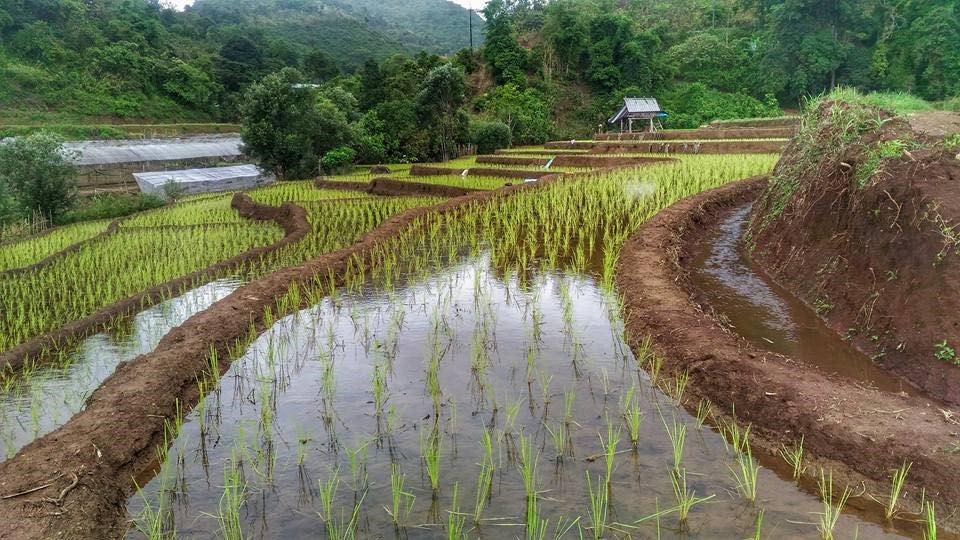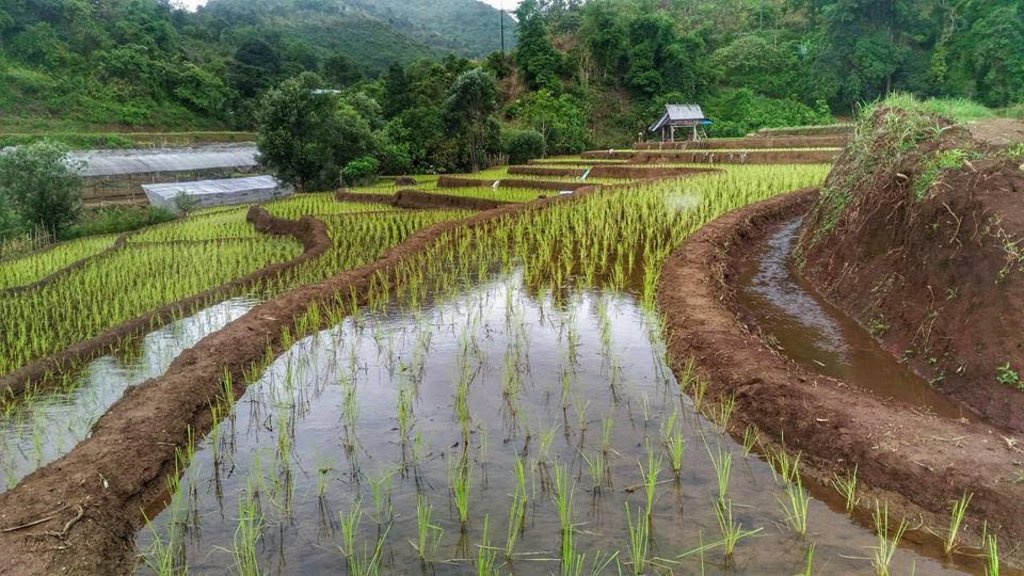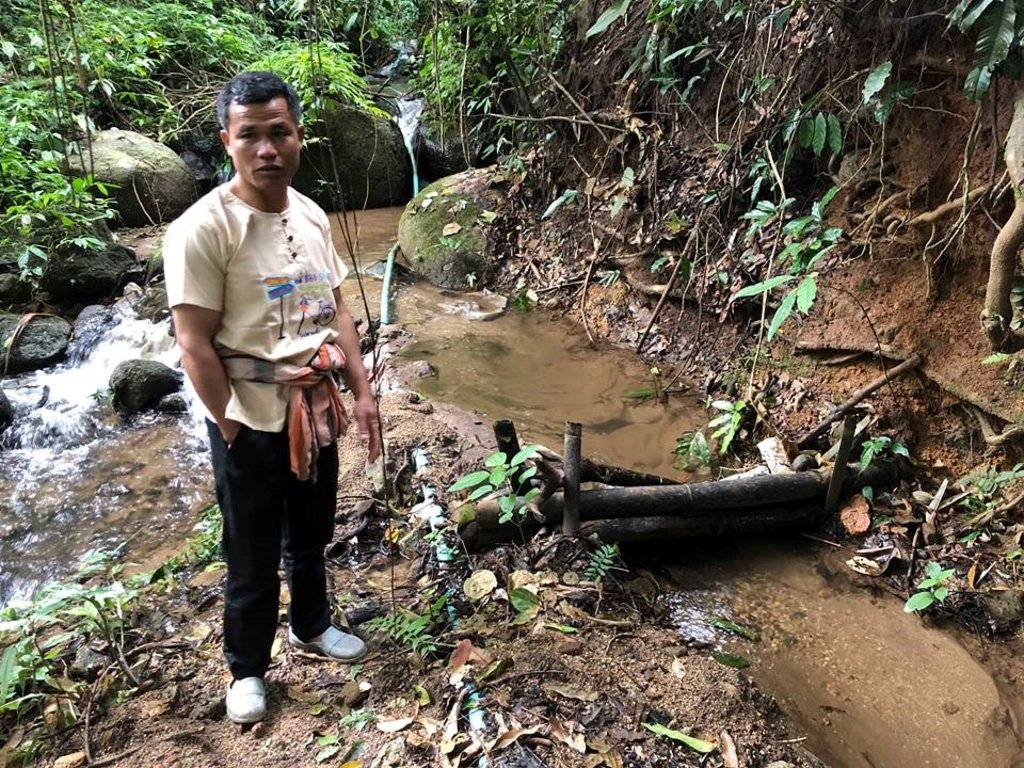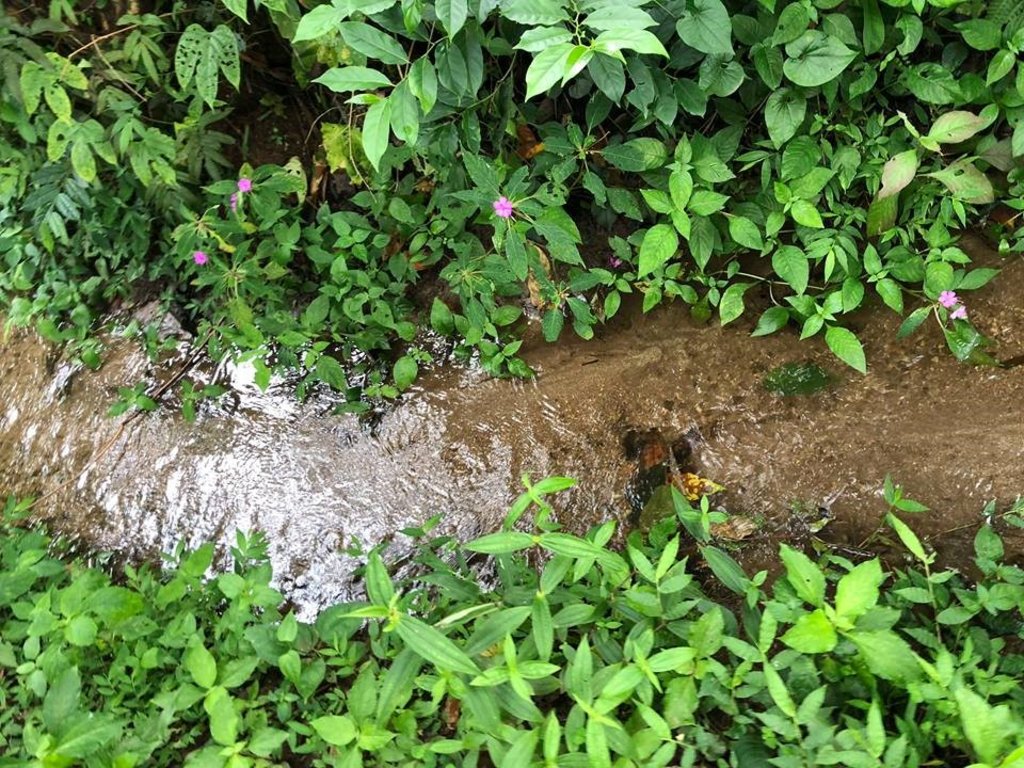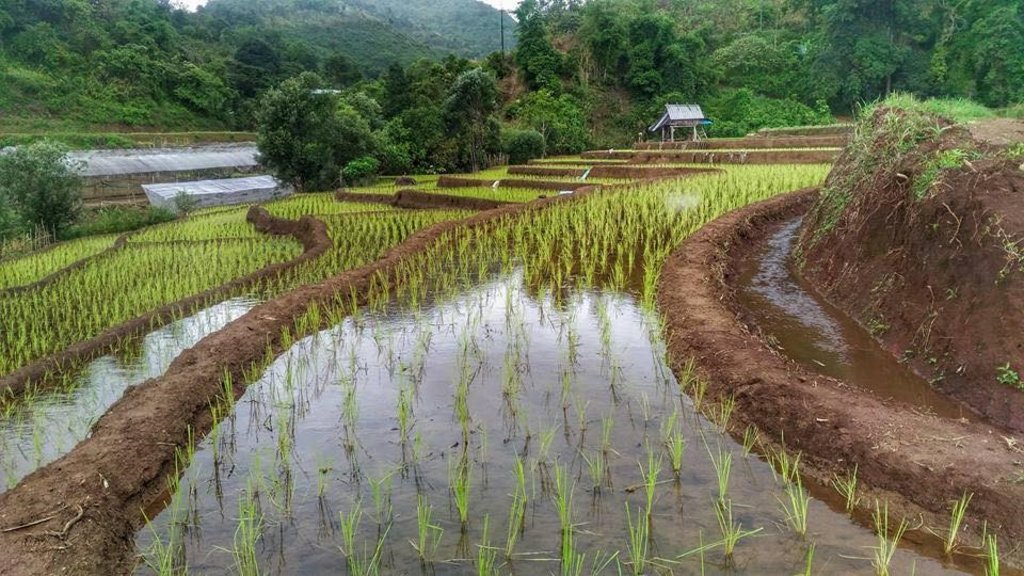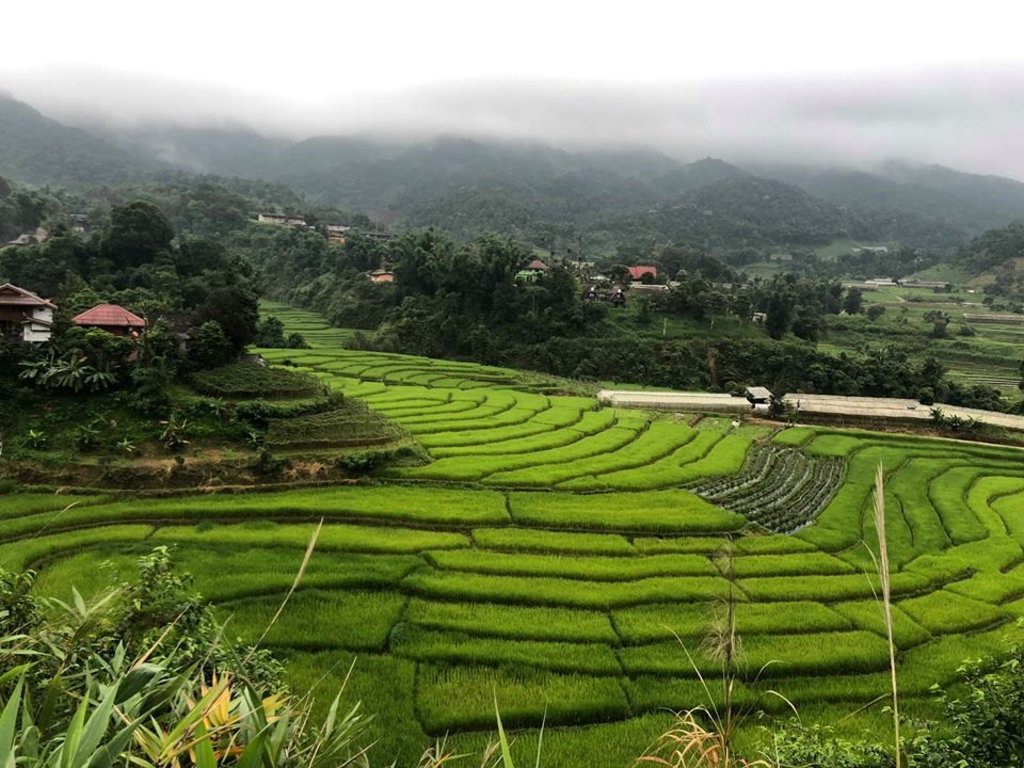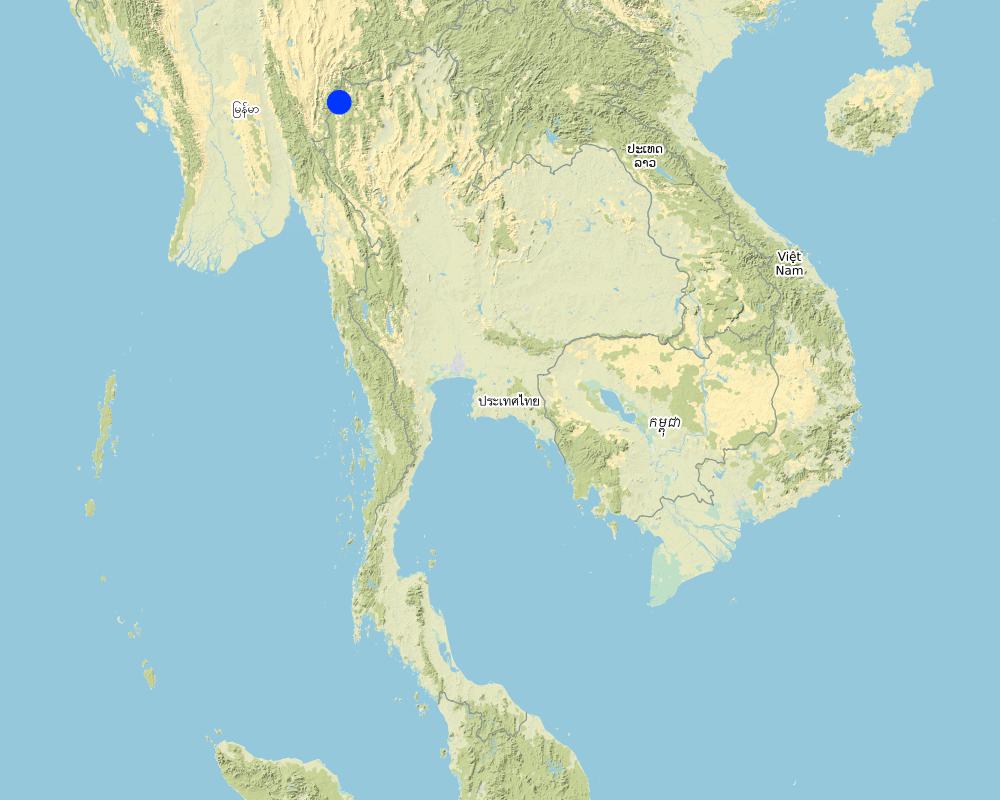Small Irrigation System for Highland Rice Terraces [Tailândia]
- Criação:
- Atualização:
- Compilador/a: Pitayakon Limtong
- Editor: –
- Revisores: Rima Mekdaschi Studer, William Critchley
Checkdam for highland rice terrace
technologies_4114 - Tailândia
Veja as seções
Expandir tudo Recolher tudo1. Informação geral
1.2 Detalhes do contato das pessoas capacitadas e instituições envolvidas na avaliação e documentação da tecnologia
Pessoa(s) capacitada(s)
Especialista em GST:
Srisomkhew Sasirin
662 579 1409 / 669 8269 6410
sasirin0928@gmail.com / sasirin0928@gmail.com
Land Development Department
Paholyothin Road, Chatuchak, Bangkok 10999, Thailand
Tailândia
SLM Consultant:
Limtong Pitayakon
66 89 444 6599
pitaya@ldd.go.th / pitaya49@msn.com
Land Development Department
Paholyothin Road, Chatuchak, Bangkok 10999, Thailand
Tailândia
usuário de terra:
Kayanyaiyie Mr.Vitoon
668 7188 0798
Soil Doctor Volunteer
Moo 5, Ban Don Village, Mae La Noi Sub-district, Huay Hom District, Mae Hong Son Province 58120
Tailândia
usuário de terra:
Kongvili Mr.Boonpan
668 4740 1550
47 Moo 5, Ban Don Village, Mae La Noi Sub-district, Huay Hom District, Mae Hong Son Province 58120
Tailândia
usuário de terra:
khangJing Mr.Suchat
668 3660 0272
1/2 Moo 5, Ban Don Village, Mae La Noi Sub-district, Huay Hom District, Mae Hong Son Province 58120
Tailândia
usuário de terra:
KangJing Mr.Somnuek
668 8764 1683
Village Headman
1 Moo 5, Ban Don Village, Mae La Noi Sub-district, Huay Hom District, Mae Hong Son Province 58120
Tailândia
Nome da(s) instituição(ões) que facilitou(ram) a documentação/ avaliação da Tecnologia (se relevante)
Land Development Department LDD (Land Development Department LDD) - Tailândia1.3 Condições em relação ao uso da informação documentada através de WOCAT
Quando os dados foram compilados (no campo)?
11/09/2018
O/a compilador/a e a(s) pessoa(s) capacitada(s) aceitam as condições relativas ao uso de dados documentados através da WOCAT:
Sim
1.4 Declaração de sustentabilidade da tecnologia descrita
A tecnologia descrita aqui é problemática em relação a degradação da terra de forma que não pode ser declarada uma tecnologia de gestão sustentável de terra?
Não
Comentários:
Water supply systems in the high landscape rice terraces can prevent land degradation and also land users can utilize this area for producing rice in limited agricultural land. Because this system slows down the water flow, it reduces soil erosion into water courses and controls the amount of water that flows from the forest upstream to the rice terraces. This system increases water available to the rice terraces and improves the utilization of water, thus maximizing benefits for growth and yield of rice.
2. Descrição da tecnologia de GST
2.1 Descrição curta da tecnologia
Definição da tecnologia:
An irrigation distribution system to highland rice terraces is required for agriculture on these highland slopes. It is based on the principles of water management in the area by diversion of water from natural watersheds upstream to the agricultural land - with regulation by village community consensus.
2.2 Descrição detalhada da tecnologia
Descrição:
The topography of this mountainous area, Mae La Noi District, Mae Hong Son Province, is complex. The height ranges from 994 -1,100 m above sea level (m asl). The main river is Mae La Noi. The climate is cool all year round. The annual average temperature is 25 degrees Celsius (⁰C), maximum temperature is 37⁰C in April, and minimum temperature is 8⁰C during December. The annual average rainfall is 1,500 mm and lasts from June to October. The number of households is 147, with total population of approx 763, 400 (Mae La Noi Royal Project Development Center, 2561). An irrigation distribution system to highland rice terraces is required for agriculture on these highland slopes. It is based on the principles of water management in the area by diversion of water from natural watersheds in the upstream areas to the agricultural land - with regulation by village community consensus. The steps of preparation are as follows. 1. Site selection: Rice terraces should be on suitable slopes, not more than 60 degrees, otherwise it will be difficult to excavate the slope and rice fields become very narrow. 2. Reshaping and leveling the slope: The sloping land for rice terrace should be reshaped and levelled by either manpower or mechanical means. The terraces can extend up to 50 m long, be as little as 1 m wide and 0.5 m deep, depending on the slope. The leveling of soil surface in the plot is done by releasing water into that plot and adjust the soil surface until a good level is attained. 3. Soil improvement: Generally, soil structure and fertility in the plots is very low because of reshaping and leveling. It is therefore necessary to restore and improve by application of organic matter, compost, animal manure, legumes, etc. Soil pH must be adjusted, and nutrients such as phosphorus and potassium should be added based on soil analytical results. 4. Rice cultivation: In the first years of cultivation, the terraces may not store water at the desired level, so rice is planted in small holes. Normally, farmers plant rice seedlings (3-5 seedlings per hole) at a spacing of 20 x 20 cm. 5. Fertilizer application: In this highland area focus should be on organic fertilizers to reduce costs, because people can find materials locally such as animal manure and plant residues. 6. Water supply system: Distribution of water to the rice terraces is managed by small dams or weirs to release suitable amount of water through a small water channel to rice terraces. This water distribution system will spread water to all land users in this area, and there is sufficient water for farming throughout the year. 7. Disease and insect control: Most rice varieties are native, so they have high resistance. But there could be some disease/insect outbreaks; they have to be protected according to instructions. The submerged condition in the paddy field can help control weeds, but some labour is still needed. 8. Maintenance: For small dams or weirs, small water channels and terraces, it is necessary to restore and maintain twice a year, i.e. before and after harvest.
2.3 Fotos da tecnologia
2.4 Vídeos da tecnologia
Data:
11/09/2018
Localização:
Mae La Noi District, Mae Hong Son Province, Thailand
Nome do cinegrafista:
Ms.Sasirin Srisomkhew
Data:
21/03/2018
Localização:
Mae La Noi District, Mae Hong Son Province, Thailand
Data:
11/09/2018
Localização:
Mae La Noi District, Mae Hong Son Province, Thailand
Nome do cinegrafista:
Ms.Sasirin Srisomkhew
2.5 País/região/locais onde a tecnologia foi aplicada e que estão cobertos nesta avaliação
País:
Tailândia
Região/Estado/Província:
Mae La Noi District, Mae Hong Son Province, Thailand
Map
×2.6 Data da implementação
Caso o ano exato seja desconhecido, indique a data aproximada:
- mais de 50 anos atrás (tradicional)
2.7 Introdução da tecnologia
Especifique como a tecnologia foi introduzida:
- Como parte do sistema tradicional (>50 anos)
3. Classificação da tecnologia de GST
3.1 Principal/principais finalidade(s) da tecnologia
- Reduz, previne, recupera a degradação do solo
- Protege uma bacia/zonas a jusante – em combinação com outra tecnologia
- Reduzir riscos de desastre
- Adaptar a mudanças climáticas/extremos e seus impactos
- Atenuar a mudanças climáticas e seus impactos
3.2 Tipo(s) atualizado(s) de uso da terra onde a tecnologia foi aplicada

Terra de cultivo
- Cultura anual
Principais plantações (colheitas para venda e consumo próprio):
Paddy rice and vegetables such as chili, cabbage

Vias navegáveis, corpo d'água, zonas úmidas
- Linhas de drenagem, vias navegáveis
Principais produtos/serviços:
Small dams or weirs with small water channels to supply/distribute water to rice terraces.
Comentários:
Farmers in the area will grow rice in the rainy season for household consumption. The duration of cultivation until harvesting is about 6 months. In the dry season, the farms are converted to several kind of vegetables under support by the Royal Project Foundation.
3.3 Mais informações sobre o uso da terra
Abastecimento de água para a terra na qual a tecnologia é aplicada:
- Precipitação natural
Comentários:
The system of water supply of this technology distributes water resources from forest upstream to the rice terrace.
Número de estações de cultivo por ano:
- 3
Especifique:
Paddy rice once a year and vegetables 1-2 crops a year
3.4 Grupo de GST ao qual pertence a tecnologia
- Medidas de curva de nível
- Desvio e drenagem de água
3.5 Difusão da tecnologia
Especifique a difusão da tecnologia:
- Aplicado em pontos específicos/concentrado numa pequena área
Comentários:
This water system covered around 200 households, each household covers an area of 0.5 hectare.
3.6 Medidas de GST contendo a tecnologia

Medidas estruturais
- S1: Terraços

Medidas de gestão
- M7: Outros
3.7 Principais tipos de degradação da terra abordados pela tecnologia

Erosão do solo pela água
3.8 Redução, prevenção ou recuperação da degradação do solo
Especifique o objetivo da tecnologia em relação a degradação da terra:
- Prevenir degradação do solo
4. Especificações técnicas, implementação de atividades, entradas e custos
4.1 Desenho técnico da tecnologia
Autor:
Ms.Sasirin Srisomkhew
Data:
25/09/2018
4.2 Especificações técnicas/ explicações do desenho técnico
The irrigation water distribution system for highland rice terraces by farmers in the village is suitable for highland, sloping agriculture, with slopes ranging from 5-60 degrees. It is based on the principles of water management in the area by diversion of water from natural watersheds in the upstream zone to the agricultural land through the consensus of community members. Distribution of water to the rice terraces is managed by small dams or weir which are used to divert and release suitable amount of water through small water channels to rice terraces. The terraces can extend up to 50m long, 1m (or more) wide and 0.5m deep, depending on the degree of the slope. This water distribution system will spread water to all land users in this area, and there is sufficient water for farming throughout the year.
4.3 Informação geral em relação ao cálculo de entradas e custos
Especifique como custos e entradas foram calculados:
- por área de tecnologia
Indique o tamanho e a unidade de área:
0.48 hectare for each farmer
Outro/moeda nacional (especifique):
Baht (THB)
Indique a taxa cambial do dólar norte americano para a moeda local (se relevante): 1 USD =:
32,0
Indique a média salarial da mão-de-obra contratada por dia:
300
4.4 Atividades de implantação
| Atividade | Tipo de medida | Periodicidade | |
|---|---|---|---|
| 1. | prepare small dam and water canal | Estrutural | in the first year |
| 2. | prepare terraces and land leveling | Estrutural | in the first year |
| 3. | cultivation | Estrutural | before rainny season |
| 4. | soil improvement | Gestão | after preparing and cultivating the soil |
| 5. | rice planting | Vegetativo | rainy season |
| 6. | fertilizer application | Gestão | after planting |
| 7. | irrigation | Gestão | after planting |
| 8. | disease, pest and weed control | Gestão | after planting |
| 9. | havesting | Agronômico | when rice grains are mature |
| 10. | None | None |
4.5 Custos e entradas necessárias para a implantação
Se possível, discrimine os custos de implantação de acordo com a seguinte tabela, especificando entradas e custos por entrada. Se não for possível, dê uma estimativa dos custos totais de implantação da tecnologia:
98100,0
| Especifique a entrada | Unidade | Quantidade | Custos por unidade | Custos totais por entrada | % dos custos arcados pelos usuários da terra | |
|---|---|---|---|---|---|---|
| Mão-de-obra | prepare dam and canal | 7x10 | 70,0 | 300,0 | 21000,0 | 100,0 |
| Mão-de-obra | planting | 7x1 | 7,0 | 300,0 | 2100,0 | 100,0 |
| Mão-de-obra | maintainance | 20x2 | 40,0 | 300,0 | 12000,0 | 100,0 |
| Mão-de-obra | harvesting | 20x7 | 140,0 | 300,0 | 42000,0 | 100,0 |
| Equipamento | tractor | set | 1,0 | 3000,0 | 3000,0 | 100,0 |
| Equipamento | fuel | liter | 20,0 | 30,0 | 600,0 | 100,0 |
| Material vegetal | rice seed | bag | 3,0 | 100,0 | 300,0 | 100,0 |
| Material vegetal | chili seed | plant | 5000,0 | 2,0 | 10000,0 | 100,0 |
| Fertilizantes e biocidas | fertilizer 21-0-0 | bag | 3,0 | 400,0 | 1200,0 | 100,0 |
| Fertilizantes e biocidas | fertilizer 15-15-15 | bag | 3,0 | 700,0 | 2100,0 | 100,0 |
| Fertilizantes e biocidas | fertilizer 16-20-0 | bag | 3,0 | 600,0 | 1800,0 | 100,0 |
| Fertilizantes e biocidas | animal manure | bag | 10,0 | 200,0 | 2000,0 | 100,0 |
| Custos totais para a implantação da tecnologia | 98100,0 | |||||
Comentários:
Labour of small and canal preparation was paid in the first year, after that paid for maintain all of these structuer.
4.6 Atividades recorrentes/manutenção
| Atividade | Tipo de medida | Periodicidade/frequência | |
|---|---|---|---|
| 1. | restoration and maintain dam, canal and terrace | Estrutural | 2 times a year |
4.7 Custos e entradas necessárias pata a manutenção/atividades recorrentes (por ano)
Se possível, discrimine os custos de manutenção de acordo com a seguinte tabela, especificando entradas e custos por entrada. Se não for possível, dê uma estimativa dos custos totais de manutenção da tecnologia:
1800,0
| Especifique a entrada | Unidade | Quantidade | Custos por unidade | Custos totais por entrada | % dos custos arcados pelos usuários da terra | |
|---|---|---|---|---|---|---|
| Mão-de-obra | restoring and maintaining the dam, water canal and terraces | 2dx3m | 6,0 | 300,0 | 1800,0 | 100,0 |
| Custos totais para a manutenção da tecnologia | 1800,0 | |||||
Se o usuário da terra arca com menos que 100% dos custos, indique quem cobre os custos remanescentes:
Land user spend their money for 100% of costs
4.8 Fatores mais importantes que afetam os custos
Descreva os fatores mais determinantes que afetam os custos:
The most important factors that affect the costs is the labour factor, where farmers need to hire labourers for rice cultivation such as planting, fertilizer application, maintaining the system and harvesting, including, the excavation and restoration of the small dam, water channels and terraces.
5. Ambiente natural e humano
5.1 Clima
Precipitação pluviométrica anual
- <250 mm
- 251-500 mm
- 501-750 mm
- 751-1.000 mm
- 1.001-1.500 mm
- 1.501-2.000 mm
- 2.001-3.000 mm
- 3.001-4.000 mm
- > 4.000 mm
Especifique a média pluviométrica anual em mm (se conhecida):
1500,00
Zona agroclimática
- Subúmido
5.2 Topografia
Declividade média:
- Plano (0-2%)
- Suave ondulado (3-5%)
- Ondulado (6-10%)
- Moderadamente ondulado (11-15%)
- Forte ondulado (16-30%)
- Montanhoso (31-60%)
- Escarpado (>60%)
Formas de relevo:
- Planalto/planície
- Cumes
- Encosta de serra
- Encosta de morro
- Sopés
- Fundos de vale
Zona de altitude:
- 0-100 m s.n.m.
- 101-500 m s.n.m.
- 501-1.000 m s.n.m.
- 1.001-1.500 m s.n.m.
- 1.501-2.000 m s.n.m.
- 2.001-2.500 m s.n.m.
- 2.501-3.000 m s.n.m.
- 3.001-4.000 m s.n.m.
- > 4.000 m s.n.m.
Indique se a tecnologia é aplicada especificamente em:
- Posições convexas
5.3 Solos
Profundidade do solo em média:
- Muito raso (0-20 cm)
- Raso (21-50 cm)
- Moderadamente profundo (51-80 cm)
- Profundo (81-120 cm)
- Muito profundo (>120 cm)
Textura do solo (solo superficial):
- Médio (limoso, siltoso)
Textura do solo (>20 cm abaixo da superfície):
- Médio (limoso, siltoso)
Matéria orgânica do solo superficial:
- Alto (>3%)
5.4 Disponibilidade e qualidade de água
Lençol freático:
Na superfície
Disponibilidade de água de superfície:
Bom
Qualidade da água (não tratada):
Água potável boa
A salinidade da água é um problema?
Não
Ocorre inundação da área?
Não
5.5 Biodiversidade
Diversidade de espécies:
- Médio
Diversidade de habitat:
- Médio
5.6 Características dos usuários da terra que utilizam a tecnologia
Sedentário ou nômade:
- Sedentário
Orientação de mercado do sistema de produção:
- Subsistência (autoabastecimento)
- Comercial/mercado
Rendimento não agrícola:
- 10-50% de toda renda
Nível relativo de riqueza:
- Média
Indivíduos ou grupos:
- Indivíduo/unidade familiar
Nível de mecanização:
- Trabalho manual
- Mecanizado/motorizado
Gênero:
- Mulheres
- Homens
Idade dos usuários da terra:
- meia-idade
- idosos
5.7 Média da área de terra própria ou arrendada por usuários da terra que utilizam a tecnologia
- < 0,5 ha
- 0,5-1 ha
- 1-2 ha
- 2-5 ha
- 5-15 ha
- 15-50 ha
- 50-100 ha
- 100-500 ha
- 500-1.000 ha
- 1.000-10.000 ha
- > 10.000 ha
É considerado pequena, média ou grande escala (referente ao contexto local)?
- Média escala
5.8 Propriedade de terra, direitos de uso da terra e de uso da água
Propriedade da terra:
- Indivíduo, não intitulado
Direitos do uso da terra:
- Comunitário (organizado)
Direitos do uso da água:
- Comunitário (organizado)
5.9 Acesso a serviços e infraestrutura
Emprego (p. ex. não agrícola):
- Pobre
- Moderado
- Bom
Energia:
- Pobre
- Moderado
- Bom
- Pobre
- Moderado
- Bom
6. Impactos e declarações finais
6.1 Impactos no local mostrados pela tecnologia
Impactos socioeconômicos
Produção
Produção agrícola
Qualidade da safra
Disponibilidade e qualidade de água
Disponibilidade de água potável
Qualidade da água potável
Disponibilidade de água para irrigação
Qualidade da água para irrigação
Renda e custos
Despesas com insumos agrícolas
Carga de trabalho
Impactos socioculturais
Segurança alimentar/auto-suficiência
Estado de saúde
Direitos do uso da terra/à água
Oportunidades culturais
Oportunidades de lazer
Instituições comunitárias
Conhecimento de GST/ degradação da terra
Impactos ecológicos
Ciclo hídrico/escoamento
Quantidade de água
Qualidade de água
Colheita/recolhimento de água
Escoamento superficial
Drenagem de excesso de água
Lençol freático/aquífero
Solo
Perda de solo
Acumulação de solo
Matéria orgânica do solo/carbono abaixo do solo
Acidez
Biodiversidade: vegetação, animais
Biomassa/carbono acima do solo
Diversidade vegetal
Diversidade animal
Espécies benéficas
Clima e redução de riscos de desastre
Impactos da inundação
Impactos da seca
Emissão de carbono e gases de efeito estufa
6.2 Impactos externos mostrados pela tecnologia
Disponibilidade de água
Caudal confiável e estável em período seco
Cheias de jusante
Sedimentação a jusante
Poluição de água subterrânea/rio
Impacto dos gases de efeito estufa
6.3 Exposição e sensibilidade da tecnologia às mudanças climáticas graduais e extremos/desastres relacionados ao clima (conforme o ponto de vista dos usuários da terra)
Mudança climática gradual
Mudança climática gradual
| Estação do ano | Tipo de mudança climática/extremo | Como a tecnologia lida com isso? | |
|---|---|---|---|
| Temperatura anual | moderadamente | ||
| Temperatura sazonal | verão | não bem | |
| Precipitação pluviométrica anual | bem |
Extremos (desastres) relacionados ao clima
Desastres meteorológicos
| Como a tecnologia lida com isso? | |
|---|---|
| Temporal local | moderadamente |
| Trovoada local | moderadamente |
| Tempestade de granizo local | moderadamente |
Desastres climatológicos
| Como a tecnologia lida com isso? | |
|---|---|
| Incêndio florestal | moderadamente |
Desastres biológicos
| Como a tecnologia lida com isso? | |
|---|---|
| Doenças epidêmicas | não bem em absoluto |
| Infestação de insetos/vermes | não bem em absoluto |
6.4 Análise do custo-benefício
Como os benefícios se comparam aos custos de implantação (do ponto de vista dos usuários da terra)?
Retornos a longo prazo:
muito positivo
Como os benefícios se comparam aos custos recorrentes/de manutenção(do ponto de vista dos usuários da terra)?
Retornos a longo prazo:
muito positivo
6.5 Adoção da tecnologia
- mais que 50%
Entre todos aqueles que adotaram a tecnologia, quantos adotaram espontaneamente, ou seja, sem receber nenhum incentivo material/pagamentos?
- 90-100%
6.6 Adaptação
A tecnologia foi recentemente modificada para adaptar-se as condições variáveis?
Não
6.7 Pontos fortes/vantagens/oportunidades da tecnologia
| Pontos fortes/vantagens/oportunidades na visão do usuário da terra |
|---|
| The villagers are self-reliant by living in balance between demand and supply to meet their own needs. So every household will grow rice for their consumption and solve some problems in water management of these rice terraces by their community. |
| Villagers have knowledge and technology of water management and systematically and continuously transfer to other land users from generation to generation, causing a connection between kinship and community. There are groups to solve the main problems of the community. |
| Villagers have a stable and strong mental state with the hard thinking to fight the obstacle in the way of living, to achieve a more prosperous life. Individual communities have strength in self-reliance, and also have strong mind in learning, having virtue and rationality in thinking and decision-making. |
| They have the ability to promote agriculture with natural resources and ecological tourism and develop the communication system for visitors to access the local information and facilities. |
| Pontos fortes/vantagens/oportunidades na visão do/a compilador/a ou de outra pessoa capacitada |
|---|
| The selection of appropriate technology can solve the problem of soil degradation, reduce soil erosion and manage adequate water supply to agricultural area for the whole year. |
| The villagers have to rely and trust on each other with high willingness to share their knowledge and experience. |
| Communities have the ability to use existing natural resources in maximizing benefits, and at the same time they try to conserve and prevent soil degradation in this area. |
| Community networking allows them to conduct activities to achieve self-reliance. |
6.8 Pontos fracos, desvantagens/riscos da tecnologia e formas de superá-los
| Pontos fracos/desvantagens/riscos na visão do usuário da terra | Como eles podem ser superados? |
|---|---|
| Land users’ lack of ownership of the land that cannot be legally owned by individuals, as the area is located in a preserved forest. The villagers therefore might be afraid to move out of the area in the future. | The community leaders and villagers need to solve this problem, one thing being that they should ask the government to help. |
| Lack of opportunities for children to have education caused by the poverty of their parents. | Schools in the area have increased educational opportunities for poor children by sponsoring underprivileged children. |
| Lack of social and health welfare because this area is far from the city. Villagers will not be able to reach the hospital in time in the case of emergency. | Villagers take the right treatment from the gold card or project 30 baht free treatment of all diseases for emergency situations. |
| Lack the coverage of energy and communication system in this area. Some areas still lack electricity, telephone and internet facilities. | Some villagers purchased and installed solar panels for their own use. |
| Pontos fracos/vantagens/riscos na visão do/a compilador/a ou de outra pessoa capacitada | Como eles podem ser superados? |
|---|---|
| The villagers lack the ownership of the land, which located in the conserved forest. That means they do not have right to hold the land. | The government has a policy to solve these problems, and at the same time serve and arrange this preserved forest as natural resource. |
| Lack of educational opportunities, The study site is located in a remote area. Children living there lack opportunities in education. | The government has a policy to give underprivileged children equal education to children. |
| Villagers lack social and health welfare because of the remoteness of the place that they live. It is difficult to access medical treatment and hospital. | The government has set up and supported the budget to develop district health promotion hospitals in the sub-district level. |
7. Referências e links
7.1 Métodos/fontes de informação
- visitas de campo, pesquisas de campo
- entrevistas com usuários de terras
- entrevistas com especialistas em GST
- compilação de relatórios e outra documentação existente
7.3 Links para informação relevante que está disponível online
Título/ descrição:
Ecological tourism of Mae La Noi Development Center, Royal Project
URL:
https://www.youtube.com/watch?v=818zn7JMKsU
Título/ descrição:
Mae La Noi Royal Project Foundation
URL:
https://www.youtube.com/watch?v=M8pFfl18fC8
Título/ descrição:
Mae La Noi Development Center of Royal Project Foundation
URL:
http://www.mhsdc.org/interest510.htm
Título/ descrição:
History of Mae La Noi Development Center
URL:
http://www.mhsdc.org/rypmaenoi.htm
Título/ descrição:
Mae La Noi Project for tourism of beautiful paddy rice terrace
URL:
https://mgronline.com/travel/detail/9590000106920
Título/ descrição:
Mae La Noi Development Center of Royal Project Foundation
URL:
http://royalprojectthailand.com/maelanoi
Título/ descrição:
Rice terrace in highland
URL:
http://www.ricethailand.go.th/rkb/management/index.php
Links e módulos
Expandir tudo Recolher tudoLinks
Não há links
Módulos
Não há módulos


